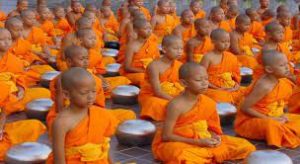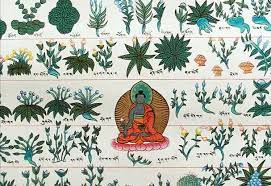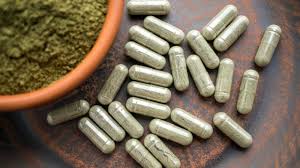Anna-Maria Haddad
Introduction
Ever since the rise of “modern” medicine, our modern world has developed an idea that skews the reality of medicine and makes it seem as though a new group of physicians met together and brainstormed what “true” and “new” medicine is. The term “modern” implies that there must be something that isn’t modern in comparison to our modern-day medicine practices. That “something” includes Buddhism and its medicinal practices. This chapter explores medicinal practices pertaining to Buddhism and how these practices created small stepping stones and paved the way for modern medicine. Underlying this discussion is a much bigger one- Is West Best? Are modern-day practices truly better and more “advanced” or are they polished to be the better and shiny echo of for instance Korean practices that are rooted within valuable Buddhist traditions? Throughout the analysis, I will focus on relating the concepts explored to the same question: is “modern medicine” truly modern or is it a slightly different version of Buddhist medicinal practices?
Exploring Buddhist meditation practices versus modern-day meditation
I would like to start with a topic that is very prominent in our lives today: mental health. It is very easy to fall into the trap of assuming that past generations fully stigmatized mental health and its significance. Let’s explore how Buddhists viewed mental health and how they alleviated stress and maintained a healthy mental state. One of the most common and popular forms of caring for one’s mental health at present is meditation. It is important for the reader to focus on the intentions behind meditation, which are rooted in freedom and positivity and kindness.
The big idea from Buddhist meditation:
- Seek inner peace,
- When focusing on breathing in meditation, the accompanying emotion should always be positivity,
- Jhana (positive thoughts), Panna (wisdom), and Karuna (compassion) must always be present in a space of meditation in order to help others,
- A new mindset and mindfulness allow for innovation and creativity,
- Clearing the mind and creating a state of mindfulness and tranquility.[1]
Here we see a huge emphasis on the emotions being driven and conveyed during meditation. The main and dominating emotion is positivity. Korean Buddhists actually warn against selfishness when meditating because it can influence the person next to you and have negative effects on the person. Thus, one must be ready and mentally available to meditate and truly benefit from such actions.[2]

Our modern world and society are heavily influenced by mental health and the stigma around it. There are many methods to maintain a healthy mind and treat mental illnesses. Among the most common forms we see today are counseling and therapy. Yet the most popular form of treatment in our modern world is drugs, especially synthesized drugs originally obtained from herbs and nature.
But there is one aspect that people seem to glance over and deem insignificant: caring for mental health through individual meditation and self-reflection. The modern world is experiencing a new wave of studies discussing the importance of meditation and self-reflection as opposed to the more common form of treatment which exists as drugs. Current studies regard walking in nature and meditation as a real and functional form of self-alleviation.[3]
Modern Physicians recommend the following for meditation:
- Doesn’t have to be long, even a few minutes are enough,
- You don’t have to be sitting, one can walk, roam, and even talk,
- Allow the mind to wander where it may wish and then refocus,
- Very self-centered,
- Time to breathe and feel better as time passes. [4]

Comparison: Buddhist versus modern-day view on meditation:
There is one overarching, prominent theme in meditation according to Buddhists: positivity. This emphasis on positivity actually stems from a place of selflessness, since it is like an “aura” radiating from the person meditating, which ultimately is going around to other people. The positivity aspect differs from modern practices of meditation. Modern-day meditation is very self-centered and stems from a place of self-love and self-prioritization. It looks like modern-day physicians wanted to focus on the self-serving aspect and leave behind what they didn’t find useful. This shows how modern-day meditation is nothing more than the bare bones of Buddhist meditation which had a much bigger role in the community as a whole.
Exploring Buddhist medicinal herbs versus modern-day herbs/drugs
Buddhist Natural Remedies:
Korean Buddhists also utilized thousands of natural remedies in order to treat diseases and infections. A study on the foods used in medicine in Buddhist temples explored the contents of the foods and what makes them particularly beneficial for treating diseases and illnesses. The published paper reveals that there were in total 563 species of plants used for treating illnesses pertaining to the digestive, respiratory, circulatory, excretory, dental, and skeletal systems. The diversity involved in combining different species of plants and which parts of the plants to use in order to treat very specific illnesses demonstrate the complexity of these practices. We often assume that Buddhists utilized random plants and were not successful at healing patients. However, the study also researched the various plants used and states that the same chemical components in the foods could easily be extracted and used as “food remedies” for obesity and geriatric diseases. The most common plant is algae. Algae underwent much research in our modern world to finally be classified as a “potential medicinal drug”. Algae contain antioxidants and anticancer and antiviral properties. However, Korean Buddhists relied heavily on it even though they lacked the modern system of scientific knowledge, this goes to show that the plants used weren’t random, but rather tested in unique ways that are not clear to us.[5]

Modern-day drugs and herbs:
Modern physcians recommend diet changes and holistic approaches to treating many illness more than ever. Dozens upon dozens of papers have been published discussing the efficacy of plants for bowel diseases.[6] The diet alterations often involve algae supplements and herbal substitutes such as chamomile tea and mint. Most of the modern drugs utilized are simply concentrated amounts of Buddhist herbs such as algae.

Comparison: Buddhist herbs versus modern-day drugs:
Looking at the different ways Buddhists and modern-day physicians treated illnesses sheds light on the fact that Buddhists paved the way for modern-day physicians. Modern-day physicians use the same recipe of drugs and herbs but in a different way. For example, they still use algae but in concentrated capsule form because they possess the necessary tools to extract and quantify their resources. The major theme here is the fact that modern-day drugs are more “advanced”, in the sense that they are simply polished versions of old Buddhist ways.
Conclusion
Throughout this chapter, modern medicinal practices and Buddhist practices were compared and discussed. Meditation as a form of mental health care from Buddhist prioritizes the other over the self, such as ensuring positive thinking and well intentions. Buddhism heavily emphasizes the importance of the “aura” one radiates during meditation. They believed in community meditation which will in turn make them feel better and improve their mental health.[7] Contrasting this with modern-day meditation we see the same goal achieved in a different manner– a more self-centered manner. Modern-day meditation involves solitary mediation which promotes self-care and self-prioritization.[8] We are still seeing Buddhism paving the way, which shows that modern medicine is simply an accumulation of older practices polished and made more appealing.
We also discussed Buddhist herbs and medicinal drugs which included hundreds of plants of different species such as algae, mint, and chamomile.[9] Comparing that to modern-day medicine, we see that modern scientists simply used more tools to extract and concentrate the same herbs and plants that Buddhists heavily relied on. From the meditation to the drugs, we see an overarching theme shedding light on the the way Buddhism paved the way and truly explored and utilized effective drugs and techniques. This also goes to prove that modern medicine is a more layered and polished echo of Buddhist medicine.
Bibliography
Groves, Paramabandhu. “Buddhist Meditation.” Psychiatric Bulletin 19, no. 2 (February 1995): 119–119. https://doi.org/10.1192/pb.19.2.119-a.
Kikut, Justyna, Nina Konecka, Maciej Ziętek, Danuta Kulpa, and Małgorzata Szczuko. “Diet Supporting Therapy for Inflammatory Bowel Diseases.” European Journal of Nutrition 60, no. 5 (August 1, 2021): 2275–91. https://doi.org/10.1007/s00394-021-02489-0.
Loh, Keng Yin. “Letter to the Editor: Meditation for Physical, Mental and Spiritual Health.” Asia Pacific Family Medicine 2 (December 2003): 239–239. https://doi.org/10.1111/j.1444-1683.2003.00098.x.
Salguero, C. Pierce. Buddhism and Medicine : An Anthology of Modern and Contemporary Sources. New York: Columbia University Press, 2019.
- Paramabandhu Groves, “Buddhist Meditation,” Psychiatric Bulletin 19, no. 2 (February 1995): 119. ↵
- Groves, “Buddhist Meditation,” 119. ↵
- Keng Yin Loh, “Letter to the Editor: Meditation for Physical, Mental and Spiritual Health,” Asia Pacific Family Medicine 2 (December 2003): 239. ↵
- Loh, "Letter to the Editor," 239. ↵
- Hyun Kim, Mi-Jang Song, and Daniel Potter, “Medicinal Efficacy of Plants Utilized as Temple Food in Traditional Korean Buddhism,” Journal of Ethnopharmacology 104, no. 1–2 (March 2006): 32–46. ↵
- Justyna Kikut et al., “Diet Supporting Therapy for Inflammatory Bowel Diseases,” European Journal of Nutrition 60, no. 5 (August 1, 2021): 2275–91. ↵
- Groves, “Buddhist Meditation, ”119. ↵
- Keng Yin Loh, “Letter to the Editor,"239. ↵
- Kim, et al.“Medicinal Efficacy of Plants Utilized as Temple Food in Traditional Korean Buddhism,” 32–46. ↵
